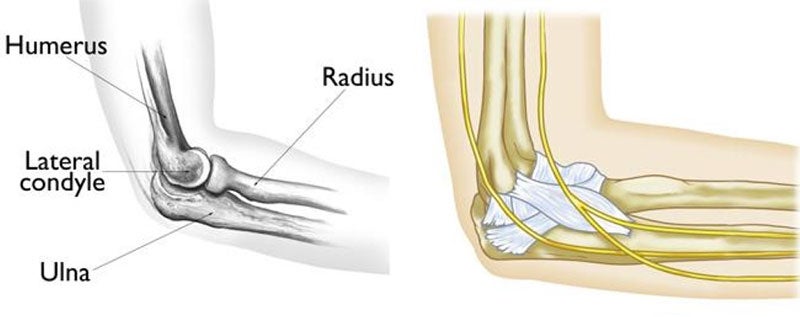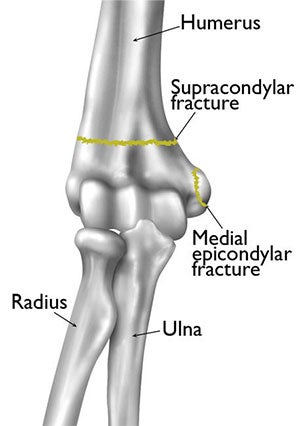
Other structures in the elbow—such as nerves, blood vessels, and ligaments—may also be injured when a fracture occurs and require treatment, as well.
The elbow is a joint made up of three bones—the humerus, radius, and ulna.
The humerus is the upper arm bone between the shoulder and the elbow.
The radius is one of the forearm bones between the elbow and wrist. The radius is on the "thumb side" of the forearm.
The ulna is the other forearm bone between the elbow and wrist, running next to the radius. The ulna is on the "pinky finger side" of the forearm.
Ligaments on the inner and outer sides of the elbow hold the joint together and muscles surround the joint on the front and back sides. The elbow joint is crossed by three major nerves.
Elbow fractures are common childhood injuries, accounting for about 10% of all childhood fractures. In many cases, a simple fracture will heal well with conservative cast treatment. Some types of elbow fractures, however, including those in which the pieces of bone are significantly out of place, may require surgery.
What are the different types of elbow fractures?

There are several types of elbow fractures, including:
- Above the elbow (supracondylar). In this type of fracture, the upper arm bone (humerus) breaks slightly above the elbow. These fractures usually occur in children younger than eight years old. This is the most common type of elbow fracture, and one of the more serious because it can result in nerve damage and impaired circulation.
- At the elbow knob (condylar). This type of fracture occurs through one of the bony knobs (condyles) at the end of the upper arm bone. Most occur through the outer, or lateral, knob. These fractures require careful treatment, because they can disrupt both the growth plate (physis) and the joint surface.
- At the inside of the elbow tip (epicondylar). At the top of each bony knob is a projection called the epicondyle. Fractures at this point usually occur on the inside, or medial, epicondyle in children from 9 to 14 years of age.
- Growth plate (physis). The upper arm bone and both forearm bones have areas of cartilage called growth plates located near the end of the bone. Because growth plates help determine the length and shape of the mature bone, a fracture that disrupts the growth plate can result in arrested growth and/or deformity if not treated promptly.
- Forearm. An elbow dislocation can break off the head of the radius bone, and excessive force can cause a compression fracture to the radius, as well. Fractures of the tip (olecranon) of the ulna are rare.
- Fracture dislocation. A fracture of the ulna associated with a dislocation of the top of the radius at the elbow is called a Monteggia fracture. If the dislocation is not recognized, and only the fracture is treated, it can lead to permanent impairment of elbow joint function.
- Open fracture. When a broken bone breaks through the skin, it is called an open fracture. An open fracture often involves damage to the muscles, tendons, and ligaments and takes a longer time to heal.
Common childhood elbow fractures include supracondylar fractures and medial epicondylar fractures.
What causes a person to break their elbow?
In most cases, elbow fractures are caused by:
- A fall on an outstretched arm
- A fall directly on the elbow
- A direct blow to the elbow
Children especially regularly engage in many activities that put them at risk for injuries to the elbow. Many elbow injuries occur on the playground when children lose their grip on the monkey bars or other equipment. For toddlers, a fall from a lower height can cause an elbow fracture. Elbow fractures may also occur in sports, such as gymnastics or football, or recreational activities such as skateboarding or bicycling. Wearing protective elbow guards and pads can help reduce the risk of a fracture about the elbow.
What are the symptoms that someone has broken their elbow?
No matter where the break occurs, most elbow fractures result in sudden, intense pain in the elbow and forearm. Other common symptoms include:
- Swelling around the elbow
- Numbness in the hand, a sign of potential nerve injury
- Inability to straighten the arm
If an elbow fracture heals in the wrong position, the elbow may remain permanently crooked and have limited range of motion. For this reason, it is important that the fracture be treated correctly at the time of the initial injury.
Treatment for elbow fractures depends on the type of fracture and the degree of displacement
How is an elbow fracture treated without surgery?
Many stable fractures can be treated by keeping them from moving with cast or splint. If the fracture is stable with no displacement, your doctor may directly apply a splint or cast to keep the bones in proper position while they heal.
Splints provide less support than casts, but they can be easily adjusted to accommodate swelling from injuries. In many cases, a splint is applied to a fresh injury first. As swelling goes down, your doctor may replace the splint full cast.
In some stable elbow fractures, the bones may need to be repositioned before applying a splint or cast. In this procedure—called a closed reduction—your doctor gently moves the arm to manipulate the bones back into place. Your child will be given some form of sedation or anesthesia for this procedure.
As the fracture heals, your doctor may schedule additional x-rays to make sure the bones stay in place.
How is an elbow fracture treated with surgery?

This x-ray shows a supracondylar humerus fracture that has been put into the correct position and held in place with two pins. The pins will be removed after healing has begun.
If the bone fragments are displaced, surgery may be needed to make sure that the fracture heals fully. Two common types of surgery are:
- Closed reduction and percutaneous pinning. In this procedure, the bone fragments that have moved out of place are repositioned during closed reduction and held in place with metal pins. The pins are inserted through the skin, into the bone and across the fracture. A splint is applied to protect the area for the first week, then is typically replaced with a cast. The pins and cast are removed after healing has begun, a few weeks after surgery.
- Open reduction and internal fixation. Open fractures, fractures that cannot be repositioned during a closed reduction, and fractures that are accompanied by nerve or vascular injuries require open surgery or open reduction and internal fixation.
How long will it take to recover from a fractured elbow?
Whether the fracture is treated by simple immobilization or with surgery, the arm will be placed in a cast or splint for three to six weeks, depending upon the fracture.
When the fracture is well enough healed, the doctor may recommend specific exercises to improve the range of motion in the joint.
In most cases, the elbow's range of motion returns to normal, or has just a mild limitation.
Departments and Programs Who Treat This Condition
Pediatric Orthopedic Surgery
Pediatric Sports Medicine Clinic
Fracture Care
Physical and Occupational Therapy
Occupational Therapy
Physical Therapy
 en
en 
 Français
Français Deutsch
Deutsch Italiano
Italiano Español
Español Tiếng Việt
Tiếng Việt Kreyol ayisyen
Kreyol ayisyen